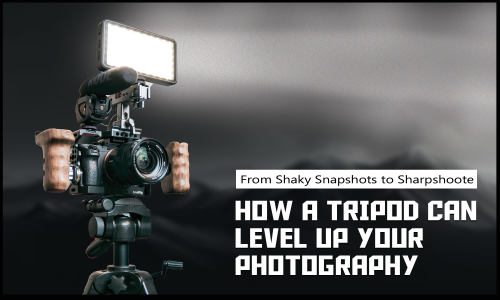A tripod, that three-legged wonder, is a photographer's and videographer's best friend. It's the quiet hero, holding your camera steady while you capture stunning landscapes, sharp portraits, and smooth videos. But with so many tripod options out there, choosing the right one can feel overwhelming. Fear not, for this guide will be your trusty compass, navigating you through the world of tripods and their diverse types.
What is a Tripod?
At its core, a tripod is a three-legged portable stand designed to support a camera or other equipment. It provides stability, eliminating camera shake and allowing you to capture sharp images and videos, even in low-light conditions. Tripods typically consist of three adjustable legs that converge at a central column or platform, where the camera mounting plate is attached. They also have a tripod head, which allows you to tilt and pan your camera for precise framing and composition.
Why Use a Tripod?
There are countless reasons why tripods are essential tools for photographers and videographers:
- Sharpness: By eliminating camera shake, tripods enable you to use slower shutter speeds, capturing crisp images in low-light situations where handheld photography would result in blurry photos.
- Clarity: Long exposures, made possible by tripods, allow you to capture stunning effects like light trails from cars or smooth flowing water in waterfalls.
- Precise Composition: Tripods give you the freedom to take your time and meticulously compose your shots, ensuring perfect alignment and horizon levels.
- Creative Versatility: Tripods open up creative possibilities like panoramas, HDR photography, and astrophotography, where precise alignment and long exposures are crucial.
- Video Stability: Smooth, professional-looking videos require a stable platform. Tripods eliminate shaky footage, ensuring your viewers can focus on the content, not the wobble.
Types of Tripods:
Now, let's delve into the exciting world of tripod types! Each kind caters to specific needs and preferences, so understanding their strengths and weaknesses will help you make the perfect choice.
1. Standard Tripods:

These are the workhorses of the tripod world, offering a good balance of stability, portability, and height. They're perfect for everyday photography, from landscapes to portraits, and are a great starting point for most users. Standard tripods typically have extendable legs with locking mechanisms, a center column for additional height adjustment, and a variety of tripod heads to choose from.
2. Travel Tripods:

As the name suggests, these tripods prioritize portability. They're compact and lightweight, making them ideal for travel and outdoor adventures. Travel tripods often have shorter legs, fold down to a smaller size, and may have features like twist-lock leg mechanisms for quick setup and breakdown.
3. Tabletop Tripods:

These mini tripods are designed for smaller cameras and smartphones. They're perfect for tabletop photography, vlogging, and product shots. Tabletop tripods are incredibly portable and can even fit in your pocket, making them ideal for on-the-go content creation.
4. Studio Tripods:

Built for heavy-duty use in the studio, these tripods are the ultimate in stability and support. They're made from sturdy materials like aluminum or carbon fiber and can handle even the most professional cameras and lenses. Studio tripods often have features like wide leg bases for added stability, crank center columns for precise height adjustments, and heavy-duty tripod heads for smooth and controlled camera movements.
5. Monopods:

Think of a monopod as a one-legged tripod. It offers more stability than handheld shooting while remaining lightweight and portable. Monopods are great for action shots, wildlife photography, and situations where space is limited.
6. Specialized Tripods:
Beyond these common types, there's a whole world of specialized tripods catering to specific needs. Suction cup tripods attach to smooth surfaces like glass or car windows, perfect for creative car shots. Underwater tripods are built for the aquatic realm, allowing you to capture stunning underwater photos and videos. The possibilities are endless!
Choosing the Right Tripod:
With so many options available, choosing the right tripod can be tricky. Here are some key factors to consider:
Weight and Portability: How much weight will you be carrying? Do you need a tripod that's easy to travel with?
Height: How tall do you need the tripod to be? Consider your camera and lens combination, and the type of photography you do.
Stability: How important is rock-solid stability for your needs? Consider factors like wind and uneven terrain.
Material: Material choices significantly impact weight, durability, and price.
- Aluminum: Affordable, lightweight, and durable, aluminum is a common choice for everyday tripods.
- Carbon Fiber: Super strong and lightweight, carbon fiber is the holy grail for professional users, but it comes at a higher price.
- Basalt: Emerging as a sustainable alternative, basalt offers strength and rigidity with a lower environmentalimpact.
Tripod Heads:
The tripod head plays a crucial role in camera movement and framing. Common types include:
- Ball Head: Provides quick and flexible ball-and-socket movement, ideal for action shots and landscape panoramas.
- Pan-Tilt Head: Offers independent pan and tilt movements, perfect for precise framing and video work.
- Fluid Head: Smoothly glides your camera for video recording, eliminating jarring shakes and ensuring professional-looking footage.
Additional Features:
- Center Column Hook: Hang a weight from the hook under the center column to improve stability, especially in windy conditions.
- Leg Angles: Look for tripods with independently adjustable leg angles for versatile setups on uneven terrain.
- Quick Release Plate: Allows you to quickly attach and detach your camera from the tripod head.
- Feet: Choose rubber feet for grip on smooth surfaces and spiked feet for digging into softer terrain.
Testing and Maintenance:
- Test the tripod before buying it. Check for wobbly joints, smooth head movements, and secure locking mechanisms.
- Invest in a proper tripod bag for protection and ease of transport.
- Regularly clean and maintain your tripod, especially the leg locks and tripod head, to ensure smooth operation and long lifespan.
Beyond the Basics:
Gimbal Stabilizers:

While not technically tripods, gimbal stabilizers offer handheld stabilization for cameras and smartphones, great for vloggers and action shots.
Imagine a motorized cradle holding your camera, constantly adjusting to counteract your movements. That's essentially what a gimbal does. Using sensors and brushless motors, it isolates your camera from bumps and wobbles, resulting in silky-smooth video that looks like it was filmed on a professional rig.
Here's what makes gimbals so awesome:
- Action-ready: Capture stunning footage while running, biking, or even skiing. No more shaky handheld video!
- Cinematic effect: Achieve that smooth, professional look you see in movies and high-end productions.
- Versatility: Works with a variety of cameras, from action cams to DSLRs, and even smartphones.
- Creative control: Many gimbals offer features like timelapse, panorama, and object tracking for even morecreative possibilities.
Tripod Accessories:
Expand your creativity with tripod accessories like Quick Release Plates, macro rails, camera straps, Center Column Hooks, L-Brackets and phone holders.
Wrap Up:
Tripods are more than just camera stands; they're the silent partners in capturing your vision. Selecting the right tripod empowers you to take your photography and videography to the next level, unlocking new possibilities and pushing creative boundaries. Remember, the perfect tripod is the one that matches your needs and style, so take your time, research, and explore the best-quality tripods in the UK that becomes your trusty companion on the journey to capturing unforgettable moments.
























